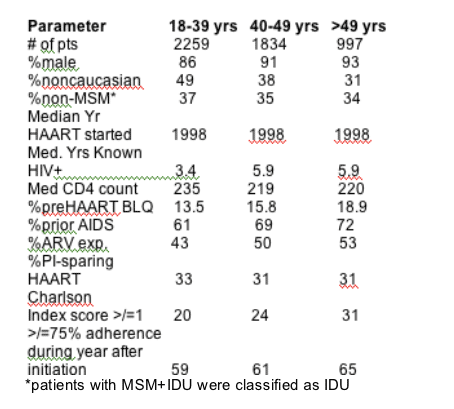 |
 |
 |
| |
Older Age Associated with Reduced HAART Tolerabilty
|
| |
| |
Reported by Jules Levin
XVI Intl AIDS Conference, Toronto, Aug 2006
HIV+ >50 Years Old More Likely to Have Abnormal Cholesterol, Elevated Glucose, Elevated Creatinine
The authors concluded:
Patients 50 years or older initiating HAART may require closer monitoring to avoid toxicities, particularly glucose and lipids, renal (creatinine), and hemotologic. Patients 40-49 yrs old also had more glucose and neutrophil abnormalities compared to those 18-39 yrs of age. Despite more adverse events, older patients must maintain high therapy adherence to maintain as robust and longer term response to HAART as younger patients. (note from Jules Levin: On this point I'm not convinced. Perhaps patients experiencing more adverse events and co-morbidities are less adherent).
Michael Silverberg, Kaiser Permanent Division of Research, reported at IAC Toronto two interesting posters regarding HIV+ individuals and their efficacy response to ART and the development of adverse events or co-morbidities.
Clinicians in the Kaiser Permanente system in northern California studied treatment responses in 997 people in their 50s or older who started a three-drug combination and in 1834 people in their 40s. The median year for starting HAART was 1998 in both groups, and both started with a median CD4 count around 220 cells/mm3. The >50 yrs group had a better chance of reaching <500 copies/ml but were morelikely to experience viral rebound 2 yrs after going under 500 copies/ml. Silverberg found adherence measured by pharmacy refills appears better in the >50 yrs group: pharmacy refill records was at least 75% in 65.4% of the 50-plus group and in 61.2% of the 40-to-49 group. In the second poster Silverberg reports finding that >50 yrs folks were more likely to experience adverse events and co-morbidities. I did not see any reasons suggested by Silverberg as to why >50 yrs group were more likely to experience viral rebound, but I'll speculate perhaps it was due to adverse events & comorbidities.
"Older Age Associated with Reduced Tolerability of Antiretrovirals"
Silverberg said the number of AIDS cases in patients older than 50 years in the USA quintupled in the last decade (Mack et al, JAIDS 2003). This study looked at all HIV+ Kaiser Permanente Northern California health plan members who initiated HAART, 1995-2004 (n=5.090). They had to have started with 3 ARTs, and patients were excluded if they lab abnormalities in the year prior to starting HAART. Lab abnormalities are based on 2004 DAIDS Table for grading the severity of adult and pediatric adverse events.
Predictors: Age; Charlson Index; refill therapy adherence; gender; race; HIV risk exposure; years known HIV+; prior immunological or clinical AIDS diagnosis; ART na´ve or exp; pre-HAART CD4 count <200, 200-349, >350; pre-HAART HIV-RNA <500, 500-9,999, >10,000; HAART initiation year; HAART class; mild grade 1 abnormality vs normal lab values.
Lab Parameters (abnormal cutoffs):
Metabolic
Total chol. Or LDL: tot chol >240 mg/dl; LDL >160 mg/dl. (n=862)
Serum glucose: >161 mg/dl (random); >126 mg/dl (fasting); <54 mg/dl).
(n=2,116)
Hematologic
Hemoglobin: <8.5 g/dl (n=4,247).
Absolute neutrophil count: <1000/mm3 (n=3,211).
Platelets: <100,000/mm3 (n=4,066.
Renal
Creatinine: >1.3 ULN (n=2,911).
Liver
Alkaline Phosphatase: >2.5 ULN (n-1,336)
Total bilirubin: >1.5 ULN (n=1,136)
ALT or AST: >2.5 ULN (n-3,450)
There was a separate analysis for each lab parameter. Mantel-Haenszel test for trend comparing prevalence of abnormalities by age. Multivariate odds ration (95^ confidence intervals) from logistic regression models adjusted for all predictors.
RESULTS

Compared to patients with ages 18-39 years, those 50 and over:
--were more likely to have higher cholesterol and glucose. The odds ratios were 1.63 and 2.91, respectively.
--were more likely to have higher hemoglobin and neutrophil levels. The odds ratios were 1.79 and 1.51, respectively.
--were more twice more likely to have creatinine abnormalities. The odds ratio was 2.14.
Metabolic Abnormalities
Total chol or LDL:
21% for 18-39 yrs;
26% for 40-49 yrs;
34% for >49 yrs
(p=0.001).
Glucose:
6% for 18-39 yrs
11.4% for 40-49 yrs
14.4% for >49 yrs
p<0.001).
Hematologic Abnormalities
Hemoglobin:
6.9% for 13-39 yrs
6.9% for 40-49 yrs
10.2% for >49 yrs
(p=0.033)
Neutrophils:
13.6% 18-39 yrs
16.5% for 40-49 yrs
15.2% for >49 yrs
pp=0.095
Renal Abnormalities
Creatinine:
3.2% for 18-39 yrs
5.8% for 40-49 yrs
8.3% for >49 yrs
p<0.001
Liver Abnormalities
Alk Phos:
5.9% for 18-39 yrs
5.4% for 40-49 yrs
5.4% for >49 yrs
p=0.721
Total bilirubin:
13.1% for 18-39 yrs
15.2% for 40-49 yrs
15.2% for >49 yrs
p=0.335
ALT or AST:
11.3% for 18-39 yrs
11.4% for 40-49 yrs
12.0% for >49 yrs
p=0.691
|
| |
|
 |
 |
|
|